Tours & Travels
Know the restrictions of Ihram, avoid them.
(Here I am, O God, at Thy command. Here I am! Thou art without associates, Thine are praise and grace and dominion. Thou art without associates, here I am!)
Of the three types of hajj, we outline the procedure for hajj At-Tamattu', for it is the most recommended. In this type, one is to perform Umrah during the hajj months (i.e., Shawwal, Thul Qa'dah and the first thirteen nights of Thul Hijjah) and to perform the hajj in the same year with a sacrifice slaughtered in Mina on one of the days of Eid al-Adhha. One may remove his Ihram garments and resume his normal activities between Umrah and hajj. But one makes the Tawaf and the Sa'i twice, the first time for Umrah and the second time for hajj. This booklet is designed to be used as a handy reference, but it cannot be a substitute for thoroughly studying hajj and sincerely preparing oneself for this great Ibadah. Please refer to the map in this booklet to follow the sequence of the rites. Allah is the giver of success. May His blessings be upon our Prophet Muhammad and all of his family and companions.
“The first Sanctuary appointed for mankind was that at Mecca, a blessed place, a guidance to the peoples; Wherein are plain memorials of God's guidance; the place where Ibrahim (Peace be upon him) stood up to pray, and whosoever entereth it is safe. And Pilgrimage to the House is a duty unto God for mankind, for him who can find a way thither. As for him who disbelieveth, let him know that lo! God is Independent of all creatures.' [3:96-97]
Ihram is the intention of the person willing to perform all rites of Umrah, hajj or both when he arrives at the Miqat. Each direction coming into Makkah has its own Miqat. It is recommended that one makes Ghusl, wear perfumes if he chooses on his body, but not the garments, and puts on a two piece garment with no headgear. The garments should be of seamless pieces of cloth. One piece to cover the upper part of the body, and another to cover the lower part. For a woman Ihram is similar except that she should not use perfumes at all and her dress should cover the whole body decently, leaving the hands and the face uncovered. Then one should utter intention according to the type of hajj. For Tamatt'u one may say, "Labbayka Allahumma Umrah" which means "O Allah I answered Your call to perform Umrah." It is recommended to repeat the hajj supplication, called Talbiyah, as frequently as possible from the time of Ihram till the time of the first stoning of Jamrat al-Aqabah in Mina (10th of Thul Hijjah). Men are recommended to utter the Talbiyah aloud while women are to say it quietly




A Muslim performing hajjut Tamattu' should intend to go into the state of Ihram, from the place where he is staying in Makkah, on the eighth day of Thul-Hijjah, which is called the Tarwiyah Day, and leave to Mina in the morning. In Mina, perform Dhuhr, Asr, Maghrib and Isha salah of the eighth day and Fajr salah of the ninth day of Thul Hijjah. Dhuhr, Asr and Isha salah are each shortened to two rak'at only, but are not combined. Remain in Mina until sunrise of the ninth day then leave to Arafat. Make sure you use the time wisely because many people will go instead for long walks trying to see things around in Mina. This is the main reason behind many Muslims getting lost in their way back and ending up wasting most of their time.
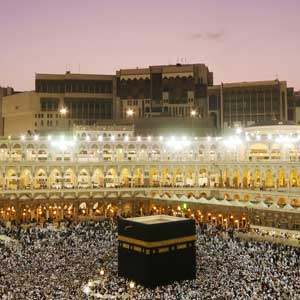

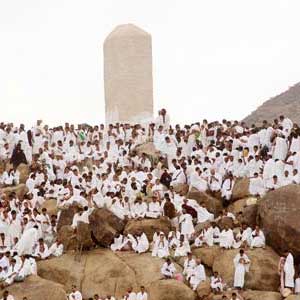

At Arafat, stay until sunset. Make salah of Dhuhr and Asr shortened and combined during the time of Dhuhr to save the rest of the day for remembering and glorifying Allah and for supplication for forgiveness, etc. Make certain that you stay within the boundaries of Arafat, not necessarily standing on the mountain of Arafat. Keep reciting Talbiyah, glorifying Allah the Greatest and repeating supplication. It is also reported that the Prophet sallallaahu alayhe wasallam, used to say the following supplication: "There is no deity worthy of worship except Allah, the One without a partner. The dominion and the praise are His and He is powerful over everything." Anas ibn Malik was asked once how he and his friends used to spend their time while walking from Mina to Arafat in the company of Prophet, sallallaahu alayhi wasallam. Anas said, 'Some of us used to cry out Talbiyah. others used to glorify Allah the Greatest and the rest used to repeat prayers. Each one of us was free to worship Allah in the way he likes without prejudice or renunciation of his right." (Bukhari)
Soon after sunset at Arafat, leave for Muzdalifah quietly and reverently The Prophet sallallaahu alayhi wasallam, said when he noticed people walking hurriedly, "O people! Be quiet, hastening is not a sign of righteousness." (Bukhari) Keep reciting the Talbiyah, glorifying and remembering. In Muzdalifah perform Maghrib and Isha combined, shortening the Isha to two rak'at. Stay overnight in Muzdalifah to perform the salatul Fajr and keep busy supplicating waiting for the brightness of the morning becomes widespread then leave to Mina passing through the sacred Mash'ar valley. Women and weak individuals are allowed to proceed to proceed to Mina at any time after midnight to avoid the crowd. Start collecting pebbles for stoning the Jamaarat.
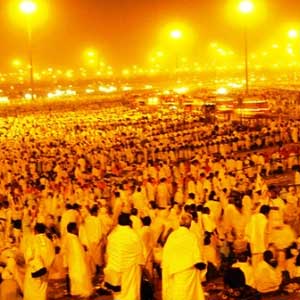

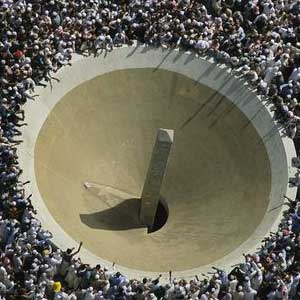

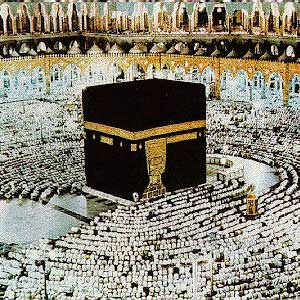

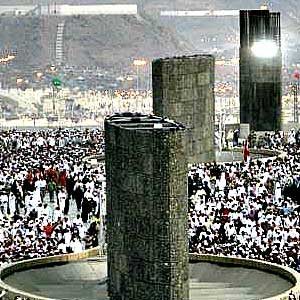

Spend there the days of Tashreeq in Mina. During each day, and after Dhuhr stone the three stone the Jamarat (the small, the medium and Jamrat al-Aqabah). You may leave Mina to Makkah on the 12th or on the 12th. If you choose the later, leave before sunset.
The Tawaf of Farewell is the final rite of hajj. Ibn Abbaas (Radhiallaahu Anhu) said, ‘The people were ordered to perform the Tawaf around the Ka’bah as the last thing (to do) before leaving Makkah, except for the menstruating women who were excused.’ (Bukhari)


Labbaik Allaahumma labbaik. Labbaika laa shareeka laka labbaika. Innal hamda, wanni’mata laka wal mulk laka. Laa shareeka laka
(Here I am, O God, at Thy command. Here I am! Thou art without associates, Thine are praise and grace and dominion. Thou art without associates, here I am!)